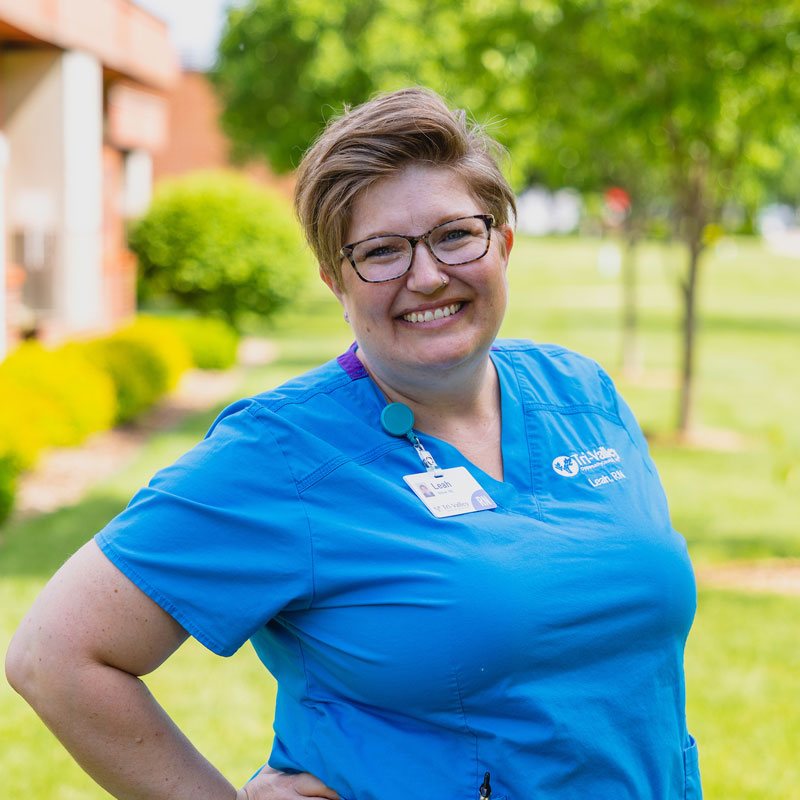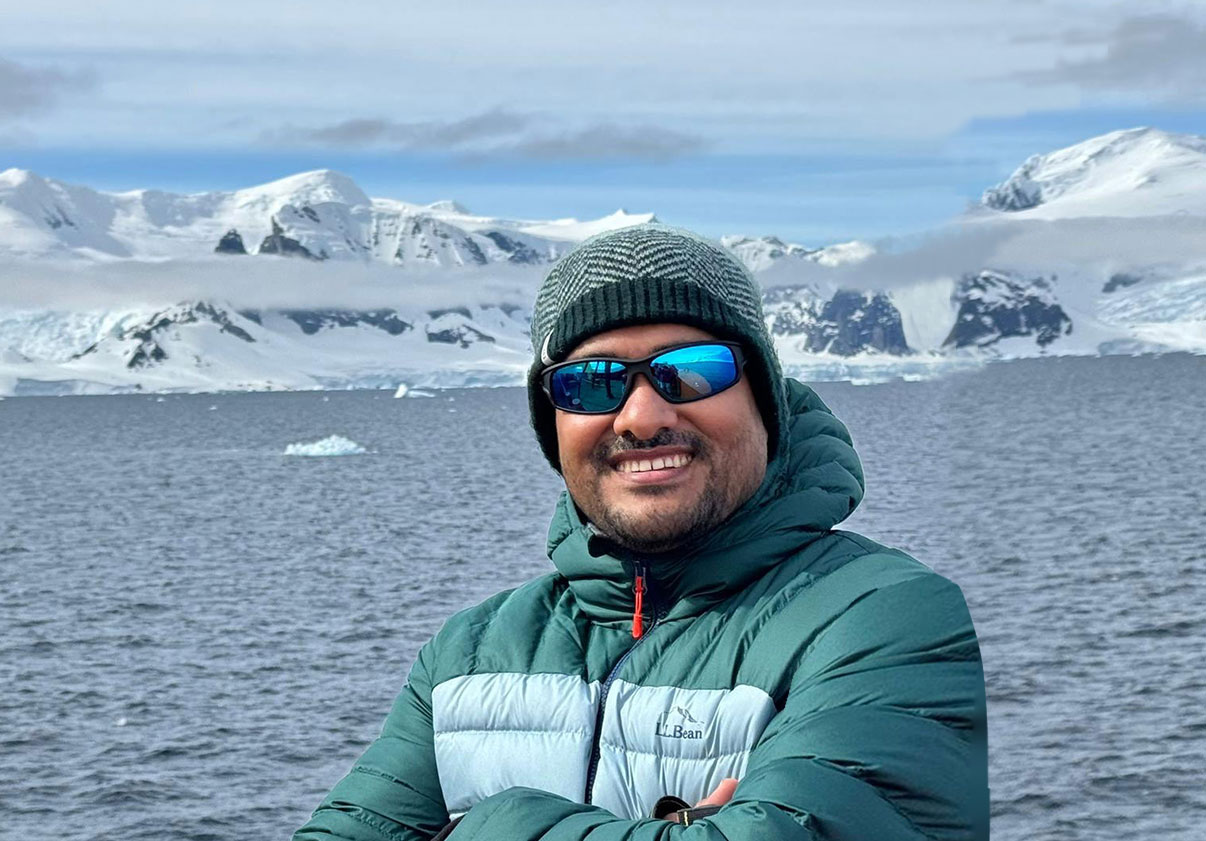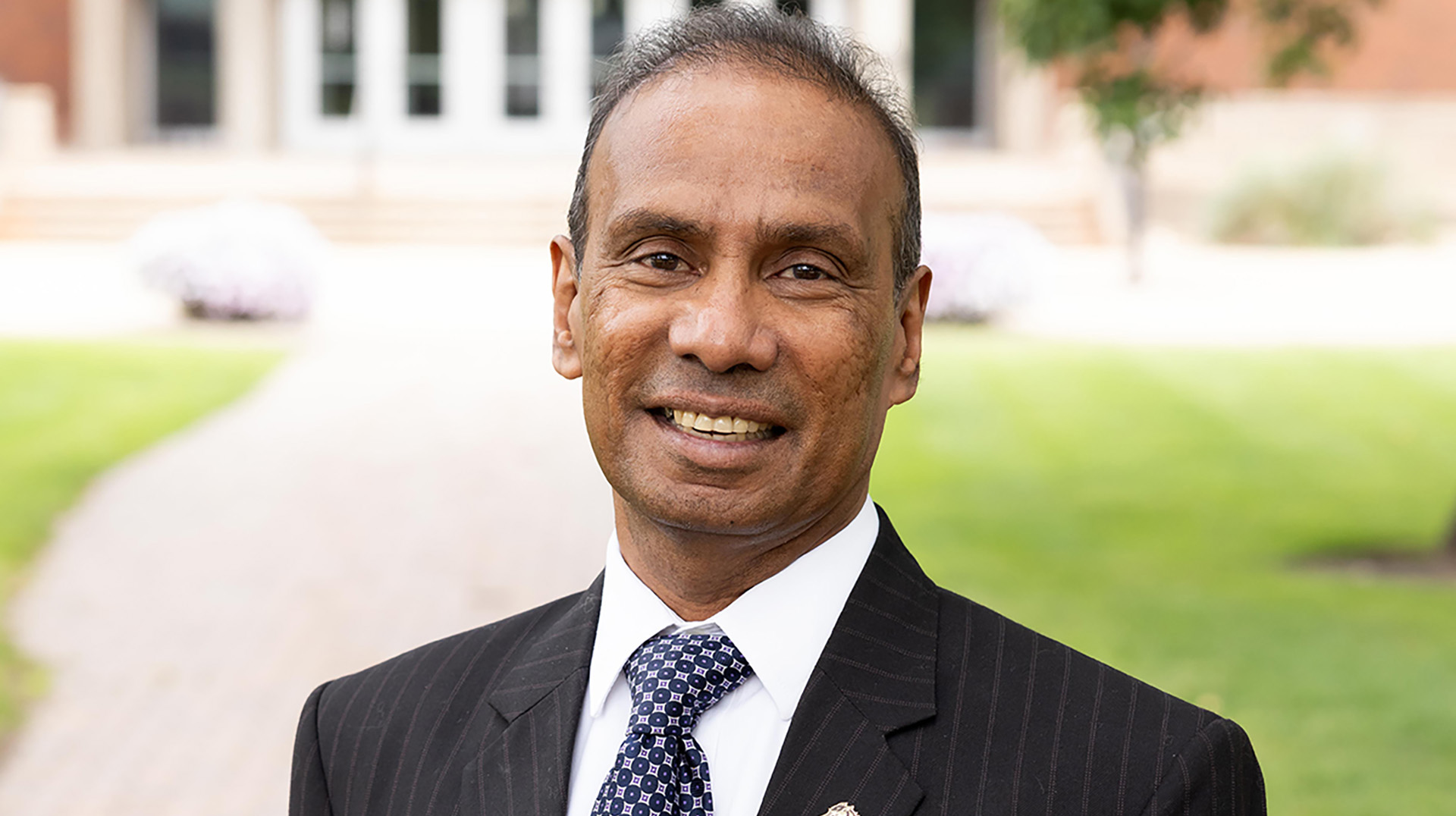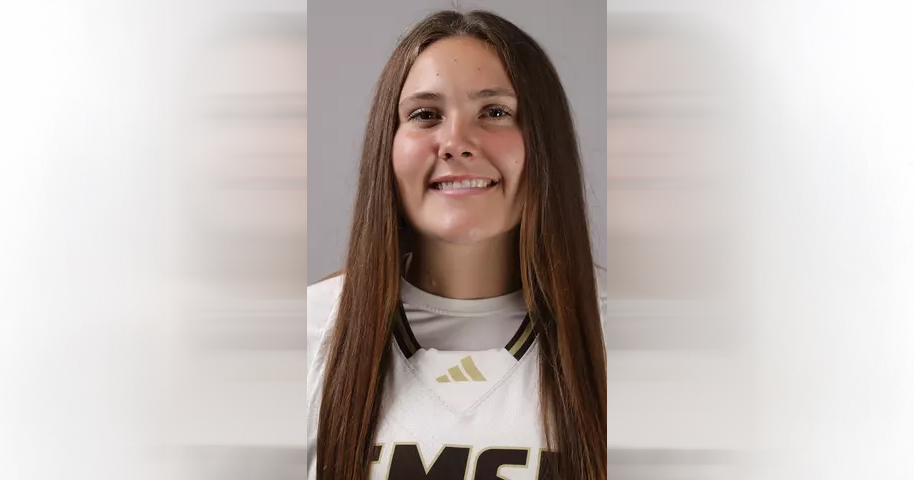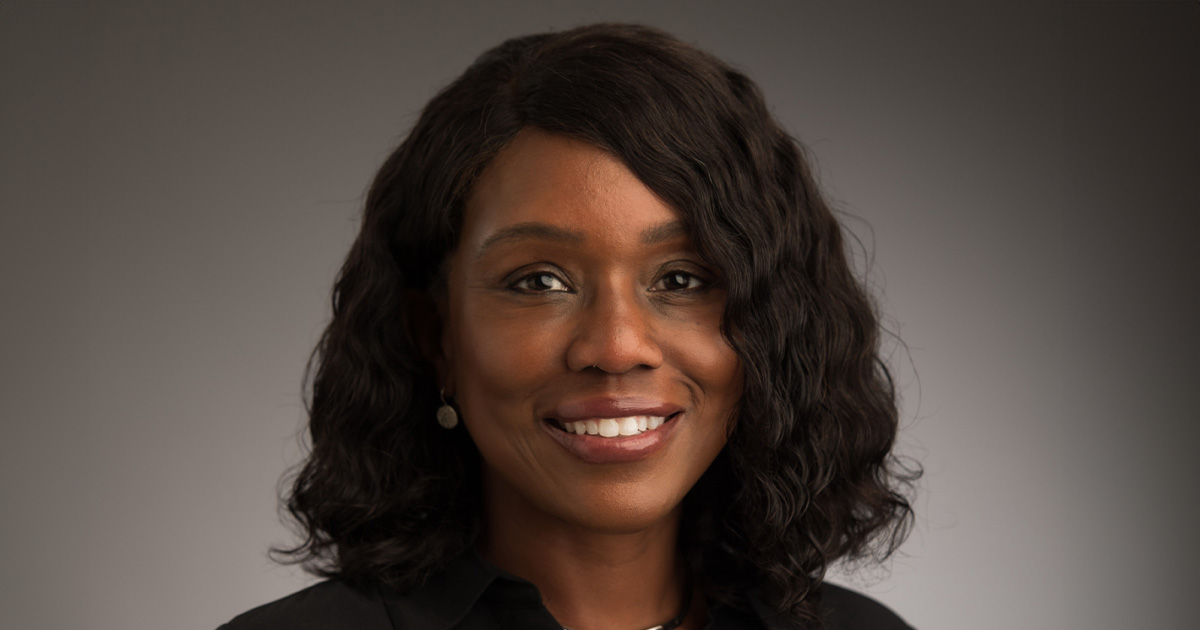Wokil Bam '12: Searching the Oceans to Fight Climate Change
Published Thursday, January 18, 2024
Wokil Bam was born and raised in landlocked Nepal. He lived in the low elevation Tarai region of the country (100-150m sea level). His Nepal is the warm flat land in the south, not the land of Mount Everest that people picture when they think of his home country.
“Where I came from it's flat, it’s really hot during summer, and it's always above freezing,” he said. “The first time I saw real snow was in Minnesota.”
Upon completing high school, Wokil was just looking into colleges. He applied to SMSU and got accepted at a couple of others, but upon looking at the finances [cost to attend] and science program, he connected with Shradda Dhungel, a Nepalese student at SMSU. After communicating with her, he knew that SMSU was the best place for him.
Having never set foot on the SMSU campus, he wasn’t prepared for the distance they would travel from the Minneapolis-St. Paul airport to Marshall. But from the start, he was impressed with his new home. It was nice, it was clean, and he was “just always surprised.” From his arrival in August, when it was incredibly hot, he and his fellow international students started looking forward to the snow. Like him, many international students have not seen snow. Ever.
And not only that, he noted that in Nepal, snow was only seen in the mountains. Coming to Minnesota and seeing that it can snow on the plains, like the landscape of his home country, was a new experience.
“Everyone I knew waited for the snow. The first snow, we saw six inches fall the second week of October, so the many international students who were living in the dorms," he said, "We went out to play soccer just behind the Student Center where the alumni plaza is now. We played soccer in the snow.”
Wokil took his first environmental science class with Dr. Emily Deaver. As a student in the major, she was also his advisor. During his junior year, he worked with her to map out how he could add chemistry as his second major. He said she was always more than happy and willing to do anything that was good for the students.
In his junior year, he also took a wetland ecology class with Dr. Deaver and knew immediately he wanted to study wetland science, more specifically, understanding the chemistry of the wetlands and water quality. That desire—and the dream his father had for him to earn at least one graduate degree—motivated him to look at graduate school.
In June 2012, he attended the International Wetland Conference organized by the Society of Wetland Scientists in Orlando, Fla. He did not give a presentation, but he received funding from SMSU so he could connect with other scientists.
“It was a big international meeting of 2,000 of the world’s top minds in the field. It was nice to be there. But at the same time, I was a bit nervous. There were people who I had read about in textbooks as an undergraduate, so I was kind of starstruck,” he said.
“I wanted to see what people do and what kind of resources are out there. I attended presentations, visited with schools, and talked to people to find out what was possible for a master’s or PhD program,” he continued. “I’m so glad went because I made a connection at the meeting and how I decided to apply to Louisiana State University.”
As he was finishing his degree in December 2012, Dr. Deaver helped Wokil with his application and writing all these resources, a teaching statement, a research statement, and a curriculum vitae. It was quite late when he applied to LSU in October 2012, but he was accepted for the master’s degree program starting in January 2013—right after graduating from SMSU.
When accepted to LSU he already knew what research he was going to do and knew the professor from the conference he attended the previous summer. LSU has over 35,000 students and Wokil hadn’t been to any other big universities or seen crowds that large. He was grateful he already knew one professor and immediately dove right into his research. At LSU, his research was focused on understanding the effect of the BP oil spill in 2010 on salt mass wetlands. For more than two years, he studied how the insect population was affected because they are an early indicator of environmental stress and recovery.
“My research was conducted three and four years after the spill in 2013 and 2014. I learned that some of the insects were growing back. But there were some isolated sites where there was no recovery at all. But in general, the population declined initially and then we started to see an increase in population.
After completing his master’s in two and half years, his research moved from salt mass wetlands to open ocean. That is where he started working on the marine carbon cycle. The ocean absorbs the carbon dioxide (CO2) from the atmosphere and the primary producer, mainly phytoplankton take the CO2 and convert it into organic matter (food). These small microorganisms take the inorganic CO2 from the atmosphere and make it organic matter via photosynthesis which becomes the first part of the ocean’s food chain. The atmospheric carbon that gets converted into organic matter during photosynthesis, is further transformed into different forms by food web processes and physical mixing, and finally gets transported to the deeper oceans. Only a small fraction of carbon fixed by phytoplankton sinks into the deeper oceans. This process of removing organic matter from surface water to the deep ocean via particle settling is known as the oceanic biological carbon pump (BCP). This carbon cycle, or movement of carbon from the atmosphere through the ocean with the help of marine life, is an important part of the Earth’s climate system.
He was involved in the research at LSU for about 6 years, but took a one-year intensive in Monaco, with the International Atomic Energy Agency, UN Agency. Their work with the marine carbon cycle complemented his doctoral work using radioisotopes to look at the carbon cycle. He returned to finish his PhD at LSU, and then moved to Woods Hole Oceanographic Institute (WHOI) as a postdoctoral scholar in June 2021. Postdoc work is a transitionary research period between completing graduate school and becoming a teaching faculty. While he is open to opportunities looking forward, he’s glad to know he has funding at WHOI to continue his research. Most of the WHOI funding is from government agencies, the National Science Foundation, the U.S. Department of Energy, as well as private philanthropy.
“Focusing on the chemistry, I study the carbon cycle, beginning with carbon dioxide in the atmosphere. Then I look at how much CO2 is absorbed by the ocean and taken to the bottom of the ocean. That is the cycle at its simplest because not all the CO2 that the ocean takes in at the surface actually makes it to the bottom,” he said. “The part that makes it to the bottom of the ocean is the most important because it is safely stored there for thousands of years.”
“When we use all these fossil fuels or burn anything, we are emitting CO2. So, if the ocean doesn't cycle the CO2, it would be double in the atmosphere. That would lead to even more elevated temperatures across the globe,” he said.
“When we talk about bigger pictures and global climate change and try to predict how the ocean will change with global warming, we use these data to model. As the ocean warms, there are places where the productivity of the carbon cycle might be higher or lower," he explained.
“Consider all these trees in the land, right? Big trees take more CO2, and small trees take less CO2; it's the same thing in the ocean. In some places, there is low productivity, but in other areas, there is high productivity. The productivity depends on various factors such as temperature, sunlight, and nutrients.”
“With all ocean zones not being the same, we use data to study trends. Where we see clear water in the middle of the ocean—when you talk about clear blue water, it's out there and it’s really, really amazing—but there is low productivity. In contrast, the coastal areas where we see high levels of riverine water, there are more phytoplankton and more nutrients cycling the atmospheric CO2,” he continued. My PhD Research was focused on understanding the carbon export in the regions of global ocean that are currently undergoing major changes, first, the Mississippi River influenced continental shelve and slope of northern Gulf of Mexico, where MS river discharge is expected to increase by more than 50% by 2100, second, the western Arctic Ocean which is undergoing rapid changes in both sea-ice cover and freshwater input and third, the continental margin of Peru where oxygen minimum zone is expected to expand by 15% by 2100.”
"When I got to Woods Hole, I’ve jumped into doing this work all over the world. In June 2021, we took a month-long cruise in the North Atlantic, west of the UK. I had another cruise that we started from West Africa all the way to Brazilian waters along the equator. And then last year I was in almost two months from Tahiti to Chile reaching the Southern Ocean and crossing the Pacific Ocean.”
From mid-November 2023 to late January 2024, Wokil will be on a 65-day research trip from Chile to Antarctica and then from there to New Zealand. This is his third research cruise longer than a month, and one of the many cruises he’s taken in the two-and-a-half years he’s been with Woods Hole Oceanographic Institute. So far, he has spent over 300 days at sea doing research.
“For all the samples we'll be collecting, we have a complete mobile lab on the vessel. We prepare for an entire year to prepare and determine what we’ll need as far as equipment, instruments, chemicals, technology, machinery, supplies, backups, and batteries for everything,” he said.
“We collect samples from not only the surface but at different depths all the way to the bottom. At some locations, the vessel will stop for three days with the team working around the clock to complete the sample collection and move to the next spot. The team includes about 30 scientists and 10 technicians helping with research, and an entire crew to support the scientists with day-to-day needs aboard ship for 65 days.”
The supplies and mobile lab equipment were shipped to Chile in early August. The participants flew to Chile on November 16, and quarantined for two days before departing on November 19 to gather water samples from new parts of the world’s oceans to better understand the potential hiding in the deep.The crew will disembark in New Zealand on January 29, 2024.
“What the ocean is doing by its natural functions is helping with the regulation of CO2 concentration atmosphere. It helps to kind of filter some of that out. This research considers questions about the whole climate change issue. The ocean is critical in regulating the atmospheric CO2, which in turn, impacts the climate,” Wokil continued.
Despite all the negative factors weighing on the climate, Wokil still remains optimistic about what can be done to steer change in a positive direction. In his oceanic research community, he’s connected to a network of scientists exploring a variety of solutions.
“We’ve heard for years that we need to plant more trees to take the CO2 out of the atmosphere. But we are limited in the available land where we can plant trees. For example, you cannot plant trees in the desert, right? So, we need to look at our oceans as the solution for climate change.”
“There are many projects underway, trying to see if we can add nutrients like iron to areas where we find deficiencies, and by bringing nutrient balance we can increase the phytoplankton growth and cycle more CO2,” he said, “Others doing research identifying places in the ocean where we can actually grow the big masses of seaweed and sink that to the bottom of the ocean to boost the CO2 removal in those areas.”
So yes, he said, there are many different pieces in the equation, but there is more hope than we think. People focus on planting trees, but because the ocean takes up 75% of the Earth's surface, there is untapped potential. The oceans are massive and deep; there is much we don't know about the activity below in the ocean twilight zone.
“We know we can control the mission now. Our institute has been actively participating in the Conference of Parties (COP) on climate change. There were many people [in the international community] who had no idea that we can take the ocean into consideration when talking about climate change.” Wokil continued. “My research is looking at trying to understand how much carbon is being taken out so we can accurately use those numbers to predict the role of the ocean and to see how we can balance the carbon cycle in general. It’s exciting work to be part of.”
So how does someone coming from a landlocked country like Nepal, with the nearest sea access over 400 miles away, go from Marshall, Minnesota to Baton Rouge, Louisiana to Woods Hole, Massachusetts to become a part-time resident on the world’s oceans?
“Coming from Nepal, I look at all the opportunities. I found that if you do not bind yourself to certain things, then many opportunities come," Wokil said. “But if you bind yourself to places or things, or if you try to limit yourself, then it's hard to jump at opportunities. My approach has always been to seek out wherever there is opportunity and try to take it. “
“And as a global citizen—it’s just the kind of person I am—I don't limit myself to one place, I go where there are opportunities or where I think I can do something good. My goal is to be a professor and keep my research going as well as teaching,” he said.
"I think I would have been lost without the good guidance from the people in regards with academics and anything that I needed,” Wokil said. “I tried to make the most of every opportunity, like river monitoring, the research conference, and getting involved in so many organizations there so if I had to do it again, I would definitely choose SMSU.”
___________________
Since June 2023, Wokil has worked as a postdoctoral investigator, geochemist, radiochemist, and chemical oceanographer in the Department of Marine Chemistry and Geochemistry at the Woods Hole Oceanographic Institution (WHOI) in Woods Hole, Mass. He was a postdoctoral scholar at WHOI from June 2021 to June 2023.
Wokil completed his PhD in Geochemistry/Chemical Oceanography from Louisiana State University in Baton Rouge, La. in May 2021. During his doctoral work, he spent one year with the International Atomic Energy Agency in Monaco. He earned his Master of Science in oceanography and coastal science from LSU in 2015.
Wokil earned his Bachelor of Science in environmental science and chemistry, and a minor in biology, from SMSU in 2012.
To explore more photos and posts from the Nov. 19 2023 – Jan. 29, 2024 follow: @wokilbam21 on X, formerly known as Twitter. To learn more about the Woods Hole Oceanographic Institute, visit: www.whoi.edu
Special thanks to Wokil Bam and WHOI for giving permission to use their photos in the Winter 2024 Focus magazine.


